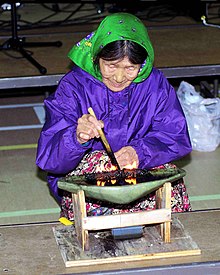Qulliq
Kudlik (plural: Qullit ; sometimes Kudlik called) is an Inuktitut -word and refers to the flat stone oil lamps shell, which for centuries the most important objects of " Eskimo counted household" and mostly from mother to one of the daughters inherited was. Made of steatite or (depending on its occurrence) the more brittle and harder serpentine , the Qulliq was used as a lamp as well as for heating and cooking food.
Seal or whale oil was mainly used as fuel , which was obtained in different ways:
- In the normal camps and on the way, seal or whale bacon was pounded with a suitable stone in the Qulliq until the oil emerged from the fatty tissue.
- In larger settlements, as they are mainly known from the time of the Thule culture (e.g. in the relics of the Thule settlement "Gate City" in Ukkusiksalik National Park ), grave-like stone structures called "Quqvik" were created, in which oil was deposited from the fatty tissue of seals or whales. To do this, the stone cavity was covered with seal skin like a cloth, then the bacon to be left out was put in and the whole thing was covered with a second seal skin. Under the influence of the sun's heat, the oil leaked out of the fatty tissue. The cold of the stone prevented it from going rancid too quickly. The process could be accelerated by applying additional pressure from above.
The oil obtained in this way was ignited with the help of a wick made from moss and peat . The flame could be improved by mixing the crushed moss with the fluff of willow blossoms. Occasionally the severed lid of a tobacco canister, pierced with nails, served as a grater to break the moss into tiny pieces. This fine moss was laid out in a narrow strip on the straight rear edge of the Qulliq and soaked in the oil. The resulting wick was easy to ignite, and its flame not only spread cozy warmth in the dwelling ( tent , igloo or Qarmaq ), but was also used to dry wet clothes and "cook". Like the Qulliq, the “cooking pot” (called Ukkusik) was made from steatite or serpentine (Inuktitut: Ukkusiksasaq). You hung it up over the Qulliq flame and could warm the food; Proper cooking of food was hardly possible under the conditions at the time.
The sleeping space in the dwelling was slightly raised and padded with furs. It usually took up the back and you slept with your head turned towards the qulliq. The woman's bed was always on the side of the Qulliq, because its maintenance was a typical household chore of Eskimo women. Even when they slept, they used charred driftwood sticks or twigs to keep the flames from going out completely. The black soot oil from the Qulliq resulting from burning was used by women for tattooing until the middle of the 20th century .
It was very common for the men to carry small qullit and moss supplies with them during trapping and hunting to warm their hands and to dry their clothes in the hunting igloo at the end of the day. Since around 1960 the Qulliq has only been in use for traditional occasions; Its place has long since been replaced by a modern industrial product that is widespread throughout the Arctic , the easily transportable, petrol- powered Coleman stove .
